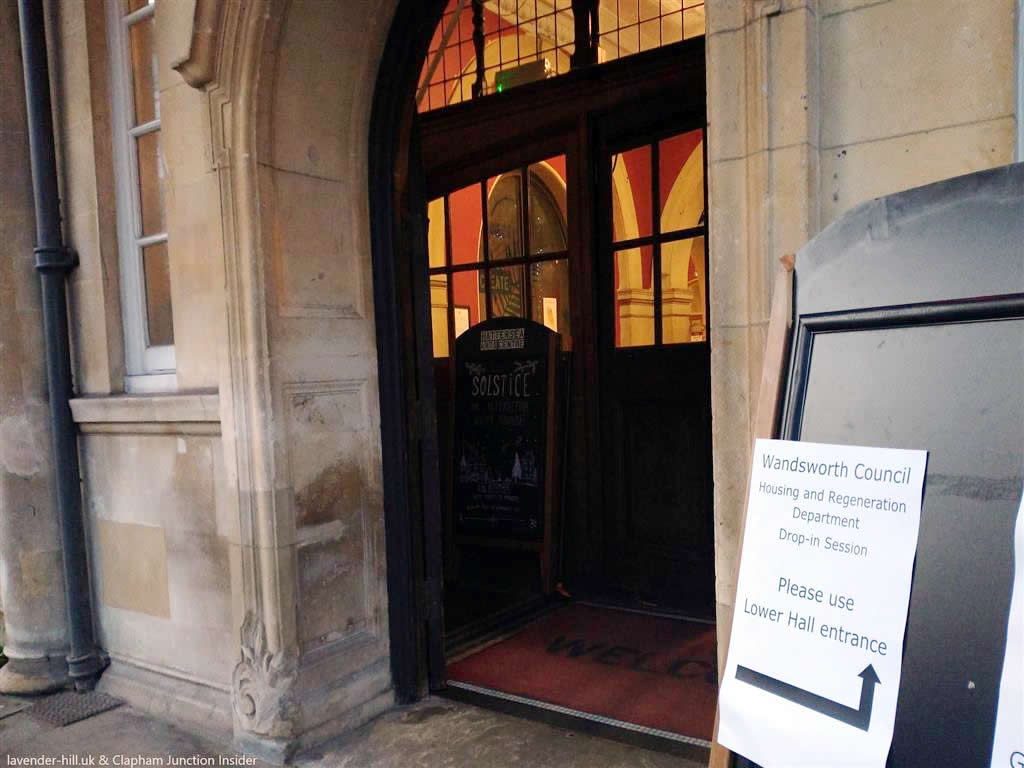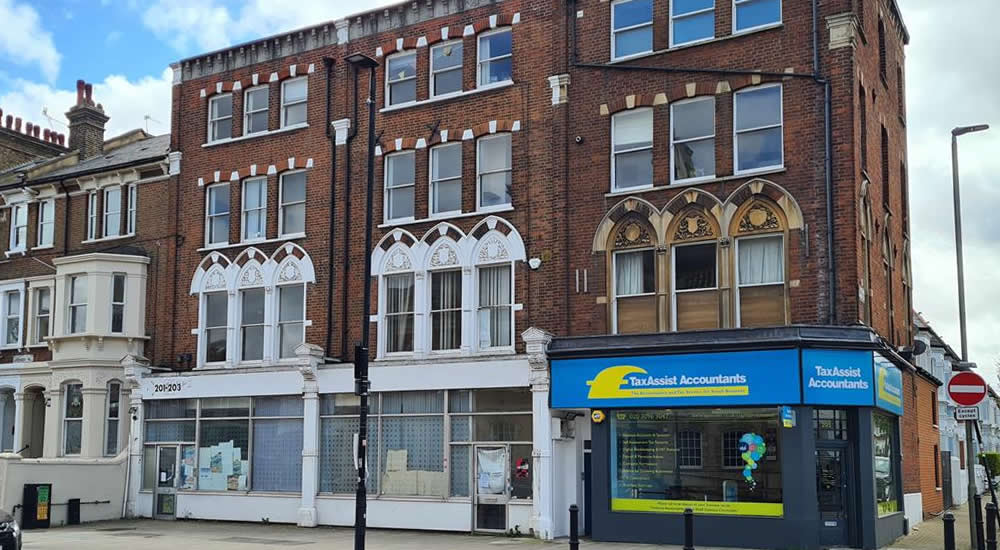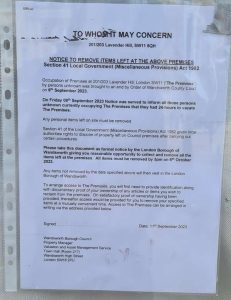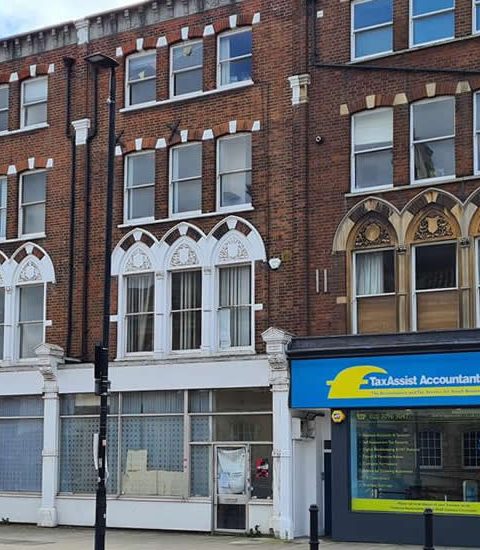The planning application to implement a rough sleeper hub in front of the Battersea Art Centre has been reactivated with, this time, a proper planning document submitted to support the scheme. All previous comments (more than 500 objections) are still listed and additional comments can be submitted until 26 April. Whether it is enough to appease the concerns of the local community remains to be seen.
We’ve written a lot about the plans for a new hub for rough sleepers proposed at 201 – 203 Lavender Hill, located in front of the Battersea Art Centre and just beside the Linden Tree Nursery. Something which could actually be a decent idea, and which is an innovative way to tackle a difficult issue and help some of the most vulnerable people in the Borough.
However the plan has been far from smooth: the Council developed the proposal in secret at the end of September (no-one noticed until the ever vigilent website lavender-hill.uk posted an article here), and put a virtually content-free planning application through the planning system in a very quiet way (as a minor change of use), which meant that it didn’t go through the usual notification processes and came as a major surprise even to next door neighbours. The planning application was actually so thin that planning officers put it on hold until the necessary information they requested was sent. At the beginning of this year, without any news, planners even envisaged that it could be completely abandoned, as we reported.
Tom Pridham, Conservatives councillor for Lavender ward (where the proposal is located), said:
“We all recognise how important it is to tackle rough sleeping and are glad that the Conservative Government has recognised this by allocating this funding. My understanding is that similar initiatives are being undertaken elsewhere.
However, we have been disappointed by the way the Council has gone about this. Early on in the process Cllr Cook and I emphasised to Council officers that it would be very important to consult openly and widely with residents about the issue to ensure that any concerns were properly addressed.”
It caused a lot of concern on many fronts, not least because traditional homeless hostels provide an important service but are, in many cases, very challenging neighbours – and the lack of detail in the plans quite understandably led many to fear the worst, by drawing a population with many challenges from the whole of Wandsworth (as well as Richmond, as this would cover both Boroughs) to a fairly quiet residential area right next to a nursery, and near a mix of small independent retailers who really don’t need any more theft and trouble. For some it resurrected memories of the crime and antisocial behaviour that came from the now-closed St Mungo’s hostel on Cedars Road – which had a laudable aim but which really struggled to contain the impact on the surrounding estate.
Many hundreds of comments were made on the original planning application by neighbouring residents and businesses. Lavender Hill is a neighbourhood of sensible and thoughtful people who are clearly pretty aware of how difficult it is to be on the streets, and many of the comments fell in to the camp of being quite understanding what the Council was maybe trying to achieve here – but at the same time being very concerned about the secrecy of the Council process, the striking lack of detail in the plans, the risk that this will prove to be a badly managed hostel bringing all the trouble that a population with addictions can draw in their wake to a non-town-centre location.
- Read our article with 12 recommendations that are needed to make this work.
The Council then ran a public meeting at Battersea Arts Centre late last year, which was quite a fiery affair at times – but where the Council officers did give a frank and decent insight to the thinking behind the plans, and also explained several changes they were making to the initial plans to address some of the concerns. It’s worth noting the Council officers were clearly thoughtful people, who were trying to do something positive with this project, rather than foist a nightmare on a far flung corner of the Borough.

We reported on the meeting in an article showing that although the Council tried to reassure on their plan, with officers noting concerns and suggestions, a number of concerns was still to be addressed.
A number of points suggested based on the planning consultation responses were addressed in full, such as creating an internal living space, not throwing residents out to roam around the streets in the day, ensuring rooms & services were only available on an appointment basis rather than drawing large numbers of hopefuls to the site in the early evenings, and the like.
However, there was less clarity on others, in particular those to safeguard neighbouring traders (for example by providing food vouchers to the population who probably wouldn’t have much of an income, to avert the shoplifting hotspots that cluster round some hostels), or on how security would avoid activities banned in the hub itself simply being displaced to quite nearby streets.
A key point was about what the new facility is trying to actually do, and how it would work. The Council officers were at pains to stress that this was not supposed to be a ‘bed for the night’ place or a straightforward halfway house, both of which are the sort of accommodation that tends to be hard to manage, and which history has shown really does not work well in residential areas. They explained that:
- It would instead be a relatively innovative facility that would try to get rough sleepers back in to a stable environment and more permanent housing – with a substantial on-site specialist day staff getting people’s lives back on track by helping both hostel residents and others with appointments to find employment and more permanent housing, and nine rooms upstairs where the length of stay would usually measured in weeks rather than days or months.
- It would also have 24 hour security staff. It would have a room for clinical appointments, but was not a methadone dispensing location; and would also provide some daytime appointments for wider outreach services – again on an appointment basis.
- The key aim is to keep rough sleepers vaguely near their support networks, and the services they need to escape the streets – rather than the current approach of the Council having to ship people off to expensive and lonely temporary rooms on the outskirts of the city or even further afield, which tends to make their problems worse by making it far harder to them get employment, practical and emotional support.
- The staff also made the (fair) point that the most troublesome and menacing individuals many neighbours will have seen causing trouble in the Borough and London more widely, are frankly speaking not the type of people that are likely to engage with this new facility – it is more targeted at the quietly struggling and somewhat invisible wider population of rough sleepers.
Not a lot more information provided since the meeting
Now obviously it’s fine to say things, and some of what we heard was indeed reassuring – but none of this was spelt out in the planning application. More details, we were assured, would follow.
But they didn’t follow, because the case went silent – for many months – with no more details being provided on the planning case. So much that at the beginning of the year, the future of the rough sleeper hub planned for Lavender Hill appeared uncertain, telling us that the application was put on hold, leading to the removal of any date for future submission to the Planning Application Committee, and that if no progress was made by the end of February, they would suggest the withdrawal of the application, with the possibility of resubmission at a later, more prepared time.
After a few months a leaflet was then distributed round nearby streets that included much of the content of the Q&A document that was distributed at the public meeting.
The only additional information that was not already displayed in the FAQ papers in December is the last QA, which commits to an idea of a dedicated community engagement lead in the facility which was expressed during the December event. Additionally, the council’s spokesperson explained that, in response to concerns regarding the adjacent nursery operations, staff will now be present on site both before and after the nursery opens and closes, which has been included in the proposal (see below).
The clock is ticking again…
And now there’s news: updated plans have gone in. And rather frustratingly, despite the talk of neighbourhood engagement, they have again gone in very quietly – in the form of a new document quietly slipped in to the back of the case file.
However, the Council told us:
“Notification was sent out on the 5th April to everyone that had provided contact details in regard to this application. Previous comments have been carried over also and we’ve put up notices on surrounding lamposts. We haven’t put on the building as that is not statutory (and we try not to advertise that it’s currently empty as it was squatted).”
The main added material is a planning application report, which summarises engagement to date with the public and the Council’s response, as well as changes to the plans. As the Wandsworth planning database seems to have some hiccups from time to time and goes offline, as a public service we’ve loaded up a copy of the most important new file here!
The document is actually a compilation of both the one page background information provided initially to justify the application, with the FAQ document published later by the Council. Additionally, it provides new information with proper planning statements (including a Fire Safety Strategy requested specifically by the planning department) and a part on detailing their efforts to communicate.
A quick skim suggests the main ‘new’ content is:
- Considerably more detail on how the building will be managed, with the Council agreeing to have the specialist ‘day’ staff on site half an hour before the nursery opens and after it closes every day, and a minimum of two security staff on site at all times, backed up by on-site CCTV (a helpful change, addressing what had been a widespread concern).
- The back of the building will now be inaccessible to residents, and windows will be frosted on that side (important – the nursery playground would otherwise be visible from a small number of bedroom windows; it’s not clear if the windows will open at the back, we’d suggest the ones on that side should be required to have restricted opening)
- The back alley will be gated (which is sensible – otherwise it risks being a gathering spot for things not allowed in the building – but there’s no clarity on how this won’t just go to the hidden away back car park on Sisters Avenue instead)
- The late night emergency beds have been removed and converted to a lounge for residents (definitely a good change – this needs to be stable and offer proper day- as well as night-time accommodation or residents to work)
- All residents required to sign a no-drugs-on-site agreement on admission, with a policy of temporary / permanent eviction for breaches.
- Confirmation no smoking or drinking ‘in communal areas’ (there had been concerns that a complete ban would merely displace that, and other problem behaviour, to the streets behind – this suggests it will be allowed in the private bedrooms which seems a reasonably sensible approach)
- A 24/7 ‘hotline’ for residents to report problems, and a Council led ‘Local Residents Forum’ to inform the community of project updates and expected timescales prior to opening, as well as a platform for residents to ask questions and raise concerns during the lifetime of the project (all welcome and worthy aims albeit there’s no detail yet – this new application detail wasn’t advertised…).
- Various minor tweaks to the planned internal layout – to provide cycle parking, a laundry facility, more clearly separated staff and resident areas (as well as the sole female bedroom, which is deliberately a bit separate – noting that 13% of Richmond’s and 16% of Wandsworth’s rough sleepers are female), and a small residents’ kitchen that can (at a push) seat six.
There is a recognition about a link between the underlying drivers of rough sleeping and wider behaviours including antisocial behaviour, burglary and shoplifting – and a statement that ‘The Hub aims to provide service users with essentials such as food, clothes and transport, as well as on site access to support services’ – potentially in the longer term reducing these challenges by getting its residents to a more stable living pattern (there’s not a lot of detail on how this will work in practice; we know it is a concern of some traders nearby). However, there is no news on the previously suggested good neighbour plans, or on the ‘resident expectation document’ including requirements on behaviour in neighbouring shops. There is a statement that on-duty staff will have ‘specific responsibilities to uphold the safety and wellbeing of local residents and business owners’ (which needs to be followed up on – retail issues are a live challenge we’ll be reporting on in a separate article).
Labour councillor Aydin Dikerdem, Wandsworth Cabinet’s lead for Housing, said:
“We have made a number of changes and commitments to these proposals based on the feedback we have received and encourage people to review the documents online.
Should the application be approved we will continue to work closely with residents, in particular developing our Good Neighbour Plan, a recommendation that emerged from the public meeting. I see this as being a meeting that takes place with service staff to review how things are going with local residents.”
The Statement of Community Involvement is relatively open about the concerns raised and goes as far as explaining that the majority of the public who attended the meeting organised by the Council in December is neither convinced nor happy with the plan:
“Local residents who attended the event were not supportive of the proposal submitted in the planning application to open a new Hub for rough sleepers. Many of the questions asked at the event can be categorised as relating to the application process and lack of communication/ pre-consultation with residents. There was a general feeling of anger towards the Council for not having consulted with local residents sooner.”
At the end of the day, the underlying questions remains regarding why Richmond and Wandsworth’s entire provision was concentrated in one location, along with the considerations regarding managing residents with complex needs in an already populated area. And eventually the decision seems based on the availability of a suitable Council building rather than addressing community expectations.
The Council could decide to turn some promises into planning conditions
You have until 26th April to comment on this revised application (albeit there is usually a bit of leeway after then) before it goes to the Planning Committee, which could be as soon as May.
It has the same case number as the old one (p.a. 2023/3434), and previous comments are still valid. However, as listed above, the new plans include a lot more detail on some operational aspects, some of it reassuring, as well as some areas where there’s more to do – and we suggest many will want to revisit the case with further comment.
Eventually, Councils don’t tend to turn down their own applications and therefore the case has a very good chance of approval. However, while the plans are now rather clearer (the previous plans were nowhere near good enough), there is still plenty of space to make suggestions on how the operations can be made to work as well as possible. The way the resident’s group will be operating, its member selected and the power it will be given could be specified. There might be some sympathy on the committee for turning some aspects of the development and management of the site into planning conditions (as without conditions, not much is really binding – even for simple things like frosting of particular windows).
Councillor Pridham said:
“Should the Council decide to press forward with this location it should be much more open in the refreshed consultation process (which I understand is underway) and take the time to engage with and address concerns properly and directly. It should also make its proposal for a residents’ liaison group, and the other commitments made in the recent leaflet delivered to residents, formal planning conditions. The Council should also include as a condition that the planning permission will need to be renewed by the Planning Applications Committee after a period, ideally 6 months to a year, to allow the Committee to consider how well the site is operating.”
To see the details, search for case 2023/3434 at wandsworth.gov.uk/planning. To see the main new document (the one we have included above) follow the link to ‘View associated application documents’, select ‘report’, ‘list documents’; the key one is called ‘Updated – assessment hub planning statement’. You can comment via the Wandsworth planning site or alternatively send comments to planning@wandsworth.gov.uk – make sure you include the case number in the subject line.
We’re also interested in your own thoughts on the case, via the comments or by direct message (contact us here).
Note: You will find part of this analysis published on our partner lavender-hill.uk which has been reported on the proposal since the beginning and was instrumental on revealing the original plan.



















